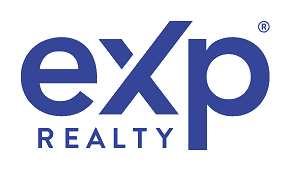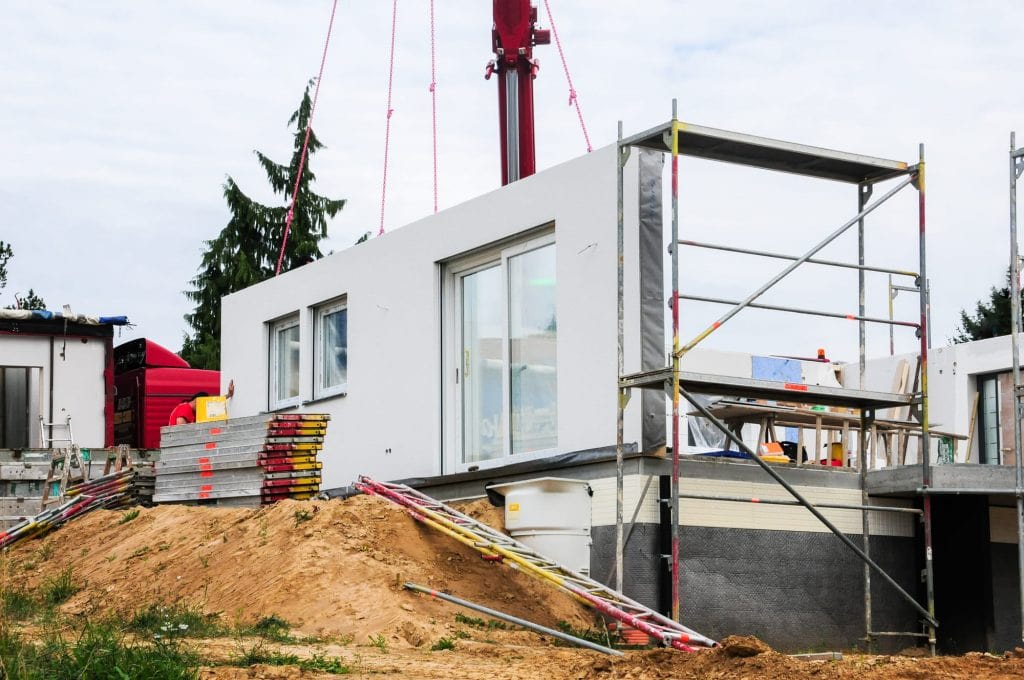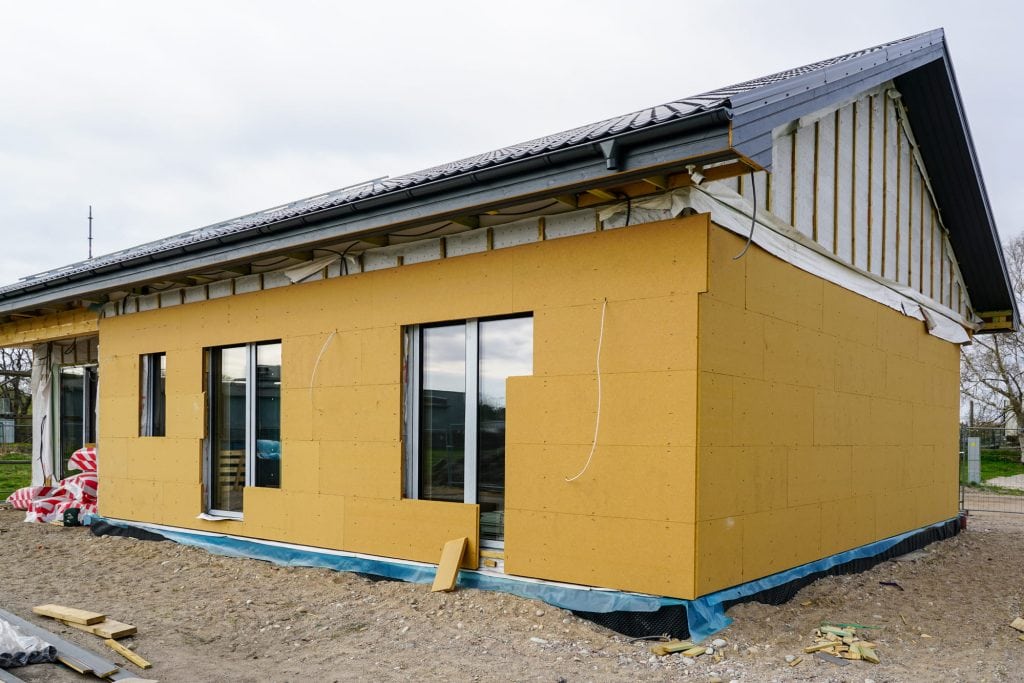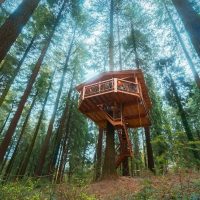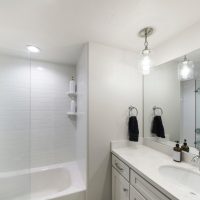When it comes to home ownership, most of us imagine the classic process of touring single-family homes for sale, working with a real estate agent, and settling down in a place we wouldn’t mind spending the rest of our days in. But a new way of constructing homes has gained traction in recent years.
Prefabricated homes, also known as prefab homes, are a hot topic in the real estate world. These homes are built in sections in a factory and then transported to the building site, where they are assembled on a foundation.
With a focus on efficient construction and modern design, prefab homes have been turning heads in the real estate industry, so let’s explore if they could be the future of our homes.
Understanding Prefab Homes
Prefab homes, short for prefabricated homes, are pre-manufactured dwellings designed and partially built off-site. Their components, often called modules, are constructed in a factory, transported to the site, and assembled by a builder. This approach to home construction disrupts traditional methods and is gradually reshaping the real estate industry.
The Appeal of Prefab Homes
Why are prefab homes capturing the interest of homebuyers and investors alike? A key reason is the scope of customization options they offer. Buyers can select from various pre-designed homes or customize their floor plans, creating a product that aligns with their unique needs and preferences. Buyers enjoy control over numerous elements of their dream home design, from square feet to architectural styles.
Moreover, prefab homes provide an accelerated construction timeline. The construction process, which utilizes modular construction techniques instead of conventional construction methods, is significantly quicker and less affected by weather delays. This efficiency is particularly advantageous to those with a tight schedule or a budget constraint.
Efficiency and Affordability
Prefab homes are more than just beautiful traditionally-styled or the dream of bringing a custom home to life. They also represent a step forward in creating energy-efficient, sustainable homes. Many prefab homes are designed to emphasize energy efficiency, incorporating elements like solar panels, floor hydronic heating, and expansive windows that invite ample natural light.
When it comes to price, prefab homes have a potential advantage too. The base price for a prefab house is often affordable compared to traditional site-built homes. While additional costs may arise from custom options, site work, and finishes, many buyers find that the overall investment remains competitive.
Variety in Prefab Homes
The term ‘prefab homes’ includes a variety of building types, including modular homes, mobile homes, and accessory dwelling units. Modular housing, for example, uses a process similar to prefab, but the homes are often larger and include more custom options.
Mobile homes, or manufactured homes, are built entirely off-site and transported to the home’s location. Accessory dwelling units are smaller structures, like guest houses or in-law suites, that can be added to an existing property.
In the world of prefab homes, there is something for everyone. Whether you’re dreaming of a compact 742-square-foot house with clean lines and cedar shingles or envisioning a 2,300-square-foot, four-bedroom home that accommodates daily life for a growing family, the possibilities are endless.
Understanding prefab homes and their potential to revolutionize the real estate industry is the first step in exploring this innovative housing solution. As they become more common and accepted, we may see an increase in these cost-effective, sustainable, and beautiful housing options.
Advantages of Prefab Homes
Prefab homes present an array of advantages for buyers, notably affordability. They often come with lower construction costs than traditional site-built homes, primarily due to the controlled factory environment where they are produced. This controlled setting reduces labor expenses and wastage of materials, leading to cost savings.
Using energy-efficient features such as double-glazed windows, solar panels, and effective insulation further enhances the cost-effectiveness of prefab homes. These elements lower the homes’ environmental impact and result in long-term savings on utility bills for the homeowner.
Another significant advantage of prefab homes lies in their speed of construction. Unlike traditional construction, which can be subject to delays due to adverse weather conditions or other unforeseen complications, prefab homes are swiftly erected, reducing the time taken from planning to occupancy.
This speed extends beyond initial construction; prefab homes can be rapidly deployed in emergencies, such as natural disasters, providing urgent housing solutions when traditional methods can’t respond quickly enough.
Sustainability and Eco-Friendly Features
Besides affordability and speed, prefab homes champion environmentally conscious living. Many prefab homes use reclaimed wood and recycled metals to incorporate sustainable materials into their construction process. Some also integrate renewable resources, including bamboo flooring and solar panels, furthering their commitment to sustainability.
Prefab homes are often designed with energy efficiency as a primary focus, reducing their overall carbon footprint. Insulation, double-glazed windows, and energy-efficient appliances are common in prefab homes, helping homeowners reduce energy usage and save on utility costs.
Furthermore, many prefab homes incorporate smart technologies and energy management systems. These features allow homeowners to monitor and control energy use more effectively, contributing to a greener living environment.
Customization and Design Flexibility
Despite their factory-built nature, prefab homes are far from one-size-fits-all solutions. They cater to diverse aesthetic preferences, offering various architectural styles. From modern minimalistic designs featuring clean lines and expansive windows walls to beautiful traditionally-styled prefabricated homes adorned with cedar shingles, there’s a prefab home to suit every taste.
The customization of prefab homes extends to the interior layout as well. Buyers can choose from various floor plans to suit their needs, whether they desire an open-concept layout filled with natural light or a more compartmentalized floor plan for defined spaces. Prefab homes can also range in size from cozy single-family homes to sprawling multi-family projects, accommodating households of all sizes.
What’s more, prefab homes provide flexibility for future changes. Whether you plan to add an accessory dwelling unit for an aging parent or create an outdoor space for entertaining, prefab homes can easily be modified or expanded to adapt to your evolving needs.
Challenges and Limitations
While prefab homes offer many advantages, it’s important to acknowledge the potential challenges and limitations. There are common perceptions and stereotypes about prefab homes that can dissuade potential buyers.
However, it’s crucial to understand that the prefab houses of today are a far cry from the simple, cookie-cutter mobile homes of the past. Today’s prefab homes offer exceptional craftsmanship, design flexibility, and energy efficiency, rivaling and often surpassing traditional homes.
One potential limitation of prefab homes could be limited customization compared to traditional construction. While it’s true that custom home builders may offer a broader range of custom options, many prefab home manufacturers also offer a wide array of customizable floor plans, exterior finish options, and interior amenities, ensuring your prefab home aligns with your specific preferences.
There may also be zoning and regulatory barriers when installing a prefab home. However, your local eXp real estate agent can guide you through the zoning regulations and building codes applicable to prefab homes in your area, making the process smoother and less daunting.
The Future of Prefab Homes
As we look to the future, prefab homes, with their unique blend of affordability, sustainability, and adaptability, are poised to impact the real estate landscape substantially.
Technological Advancements and Innovations
Technological innovation is one of the key drivers of the rise in popularity of prefab homes. For instance, digital tools are transforming the prefab home design and customization process. Software programs enable homebuyers to visualize different floor plan dimensions, exterior options, and even floor coverings, creating their dream home design virtually before construction begins.
Modular construction techniques, focusing on precision and efficiency, have advanced significantly, facilitating the production of high-quality, durable homes.
Some manufacturers are also innovating in the realm of offsite construction solutions, offering complete construction of prefab homes in a factory-controlled environment. This accelerated construction timeline not only significantly reduces the potential for construction delays but also assures a consistent level of quality control unachievable in traditional construction methods.
Integration of Sustainable and Smart Technologies
The prefab homes of the future are likely to be more sustainable and smarter. Many prefab homes already incorporate energy-efficient construction methods, and this trend is expected to continue, with an emphasis on integrating renewable energy sources. Solar panels, energy management systems, and extra-robust building envelopes are just some of the features we can expect to become more common.
Smart technology integration is also on the rise in prefab homes. From smart thermostats and lighting systems to home security and entertainment systems, these homes are designed to accommodate the conveniences of modern daily life.
Addressing Housing Crises and Affordable Housing Shortages
Prefab homes have enormous potential to address pressing housing crises worldwide, especially in areas with severe affordable housing shortages. Their lower base price than site-built homes and quicker construction times make them an attractive solution for rapid and cost-effective housing.
Whether used as permanent single-family homes, accessory dwellings, or temporary emergency housing, prefab homes offer an efficient, affordable, and customizable housing revolution. Companies like Boxabl are already making waves in this area, offering tiny homes at an affordable price that can be set up in just a day.
The Future of Prefab Homes
As we look to the future, prefab homes, with their unique blend of affordability, sustainability, and adaptability, are poised to substantially impact the real estate landscape.
Technological innovation is one of the key drivers of the rise in popularity of prefab homes. For instance, digital tools are transforming the design and customization process. Software programs enable homebuyers to visualize different floor plan dimensions, exterior options, and even floor coverings, virtually creating their dream home design before construction begins.
Some manufacturers are also innovating in offsite construction solutions, offering complete construction of prefab homes in a factory-controlled environment. This accelerated construction timeline not only significantly reduces the potential for construction delays but also assures a consistent level of quality control unachievable in traditional construction methods.
The prefab homes of the future are likely to be more sustainable and smarter. Many prefab homes already incorporate energy-efficient construction methods, and this trend is expected to continue, with an emphasis on integrating renewable energy sources. Solar panels, energy management systems, and extra-robust building envelopes are just some features we can expect to become more common.
Key Takeaways
With their unique blend of affordability, eco-friendliness, and customization flexibility, Prefab homes offer a compelling alternative to traditional site-built homes. These modern dwellings promise quicker construction times and a vast array of design options, with the added benefit of being less impacted by weather delays.
Prefab homes are at the forefront of integrating sustainable and smart technologies, underscoring their potential to reshape the future of the real estate sector.
Whether you’re considering downsizing, looking for a greener home, or seeking an affordable entry into homeownership, the world of prefab homes holds promising opportunities. Embark on your home-buying journey by exploring your options with the help of a trusted real estate professional. You can also sign up to get daily or weekly alerts of new property listings.
FAQs: Prefab Homes
Here are some of the most commonly asked questions regarding prefab homes.
Is it cheaper to build or buy prefab?
Building a prefab home can be more cost-effective than constructing a traditional site-built home. Savings stem from reduced labor costs, less waste, and the ability to control building costs in a factory setting.
What is the difference between prefab and modular homes?
Prefab is an umbrella term for homes built partially or entirely off-site. Modular homes, a type of prefab, are built in sections or modules in a factory and then assembled on-site.
Is prefab the same as manufactured?
No, prefab homes and manufactured homes are different. Prefab homes include a range of home types, including modular homes. In contrast, manufactured homes, previously known as mobile homes, are built entirely off-site and transported to their final location.
Who is the largest modular home manufacturer?
While several large companies manufacture modular homes, Champion Homes is one of the largest in the United States, producing a wide variety of prefab and modular homes.
What is the advantage of prefab?
Prefab homes offer many advantages, including cost savings, faster construction times, reduced environmental impact, and a high degree of customization.
What are the types of prefab?
Prefab includes various types of homes, including modular, panel-built, and pre-cut homes. Each type varies in terms of construction techniques, customizability, and assembly methods.
